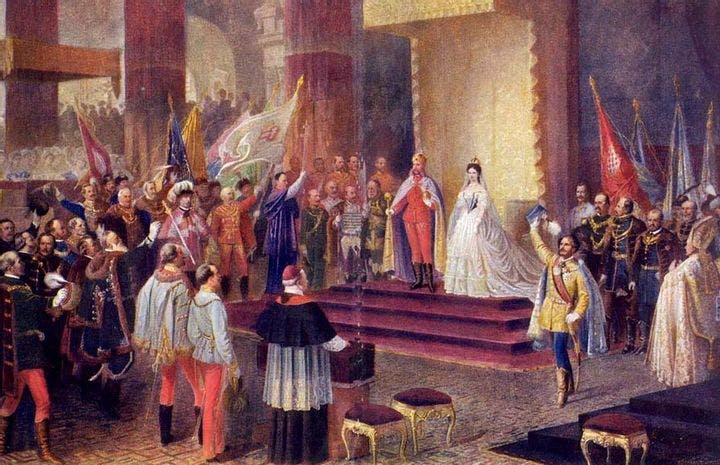Fall 2008
A Habsburg Plan for Brussels
– The Wilson Quarterly
The Brussels-based leaders of the European Union might take a page from the Habsburg playbook in dealing with the problems of unifying its varied countries under one banner.
Few modern political devel-opments seem more counterintuitive than the unification of 27 states that not so long ago were fighting one another in two savage world wars. The European Union now features a single currency, open borders, and an array of common policies on everything from the proper size of tomatoes to noise pollution.
Remedies for some of the European Union's growing pains may lie in lessons learned from the Habsburg Empire.
The march toward unity, however, has found more than a few of its 27 divisions downright mutinous. As the leaders of the EU forge an “ever closer union,” member states are fighting to preserve national vetoes and voters are demanding the right to hold referendums on a multitude of issues.
The answer for Europe, according to A. Wess Mitchell, research director at the Center for European Policy Analysis in Washington, is to seize the political playbook from an imperial court more famous for its Lipizzaner horses than its achievements in governance—the Habsburgs. The jigsaw Austro-Hungarian Empire presided over by Emperor-King Franz Josef I from 1867 to 1916 embraced 14 language groups and 11 nationalities. Of its 51 million inhabitants, half were Slavs, a quarter Germans, and a quarter Magyars, with scattered Italians and Romanians. It was a pseudo-democratic monarchy that kept the peace for half a century, and it worked by devolution.
After failing to adopt a centralized constitution, Franz Josef’s imperial bureaucrats decided to save the empire not by tightening control over their fractious subjects but by loosening it. They gave Austria and Hungary separate parliaments, with unprecedented political autonomy. They established unique conditions for economic success by setting up a vast single market that allowed people to buy and sell with a single currency, travel on an unbroken network of roads and railways, conduct business across a grid of telegraph and mail lines, draw credit from a common banking system, and invest under the umbrella of universally recognized laws. They let the two “halves” of their empire make their own domestic and fiscal policies. The enterprise fell apart only when the Czechs and Slavs demanded similar political power and the emperor tried instead to tighten up.
Brussels should learn two lessons from Vienna, Mitchell writes. First, “a multinational union’s chances of success increase in inverse proportion to its determination to concentrate political power at the center.” Second, Bill Clinton had it right when he rested his election campaign strategy on the notion that “it’s the economy, stupid.” Give primacy to economic integration.
America, too, can learn a Habsburg lesson: Don’t push—or appear to push—the European states toward more unification than their own citizens are ready for, and cultivate countries willing to work with Washington on a bilateral basis rather than pursue a top-down strategy. The new member states of Central Europe have common interests with the United States. A smart superpower works with the little guys.
* * *
THE SOURCE: “Empire by Devolution: What Today’s EU Can Learn From Franz Josef I’s Empire” by A. Wess Mitchell, in Orbis, Summer 2008.
Image courtesy of Wikimedia Commons
